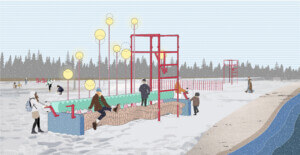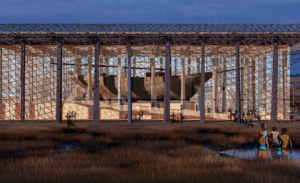While a winner has not yet been selected, Tex-Fab’s new APPLIED: Research Through Fabrication competition has already produced interesting results as four semi-finalists emerge. The competition solicited proposals that best displayed “research through computational fabrication.” The four proposals selected in the first round of adjudication address acoustics, structure, construction, material, and surface effects, each using on digital modeling and fabrication techniques. The proposals, described in more detail below, will be shown at ACADIA 2012 this October at the Synthetic Digital Ecologies conference, hosted at the California College of the Arts.
Spin Valence
Emily Baker
With a repeated pattern of shapes cut into a single sheet of steel, a steel panel can become two planes joined by repeated triangulating struts. Each shape is individually spun out of the original panel and then rejoined to surrounding units. The completed construction is structurally sound, light diffusing, and inexpensive to construct.
FAB POD
Jane Burry and Nicholas Williams
FAB POD explores the potential of hyperbolic surfaces to create an acoustically controlled space that can be constructed and deconstructed in different settings. The hyperboloid surface forms allow the designers to experiment with sound diffusion, less understood than sound absorption and reverberation. Each piece of the structure is conceived using digital modeling materialized using gypsum plaster and laser-cut formwork.
Cast Thicket
Christine Yogiaman and Ken Tracy
Cast Thicket is both a form of construction and a finished design product. To produce finished forms of reinforced concrete, construction begins with the design of prefabricated steel struts, which are positioned using a system of interlocking laser-cut plates. Formwork is also prefabricated and attached to the joints. Plastic formwork is then detached and reattached as the structure grows upwards. The final product has the possibility for infinite variation.
Latent Methods
Eli Allen
The Latent Methods project focuses on exploring the possibilities of an existing material—in this case, shingles. The process begins with exploration of possible forms before they are “rationalization and articulation of…digital models through parametric tools.” Computer models then determine the process of shingle size and placement, giving a designer the ability to create Gehry-esque forms coated in a traditional material.
More information on these proposals, the competition, and other entries can be found at Tex-Fab’s website. Click on a thumbnail below to launch the slideshow.










